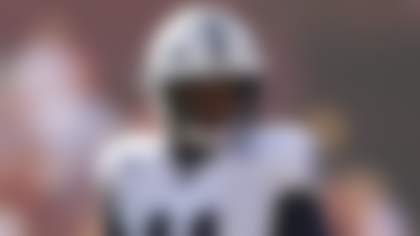NFL offensive coordinators have literally had the ear of their quarterbacks since 1994.
Beginning that year, coaches were allowed to discuss plays and strategies with their quarterbacks before the snap via a coach-to-QB communication system inside the player's helmet.
This year, for the first time, defenses will enjoy the same benefit. Like their offensive counterparts, defensive coordinators will designate a player to wear a "live" helmet equipped with a Motorola transmitter.
Two defensive players will have "live" helmets, but only one of those helmets can be on the field at a time. If a primary player's equipment malfunctions or he sustains an injury, only then can a backup player's "live" helmet be used. Offensive and defensive helmets with the communication capability will be identified with a prominently displayed green dot.
Several NFL players experimented with the new technology during OTAs and minicamps this year, including linebacker David Thornton, who will be the primary Titans defensive player to be equipped with the coach-to-defense technology this season.
"I really enjoyed it," says Thornton. "I think it evens things out a little bit. Hopefully it will let us communicate a little better on Sundays."
As with the offensive transmitters, the defensive devices will go live immediately after the play clock begins and will remain active until 15 seconds are left on the play clock or the snap of the ball, whichever comes first.
"It's not a big adjustment for me," says Houston TexansPro Bowl linebacker DeMeco Ryans, who also wore a "live" helmet during minicamp. "Usually, you don't have a coach talking to you until you get to the sidelines. Now, he's in your ear on the field."
Much like the offensive helmet transmitter, the "live" defensive helmets will employ a frequency system that has 268 million different encryption codes, making it indecipherable to anyone trying to listen in. Several other clubs, including the Bills and Packers, tinkered with the new technology during offseason workouts. Players and coaches from both teams are excited about the innovation.
"The communication will be a lot smoother because you won't have to signal," says Buffalo head coach Dick Jauron. "You still need to have signals as a backup in case the device goes down. But it's better. It's better."
One of Jauron's star defenders, linebacker Paul Posluszny, agrees.
"To have that short communication with the coach will help us and will make everything more clear," says Posluszny. "We won't be fighting to make sure we can get the signal or see the signal. So to have that will make things way more efficient."
As with any new technology or rule change, there will be a period of adjustment. But Green Bay head coach Mike McCarthy thinks it will be an easy transition for defensive coaches and players.
"We'll continue to get the players used to it, having the voice in their ear, and also the time frame that you're able to talk to the defensive player," he says. "We've used it throughout OTAs and minicamps, and it's really gone very smooth."
Here's a closer look at how the coach-to-defense system will be administered this season:
» Two defensive players from each team will be identified and will be authorized to have receivers in their helmets, one as the primary and the other as the backup.
» The primary player will have one "live" helmet on the field and a second "live" helmet stored in a secured trunk or container as a backup in case of a malfunction.
» The backup player will wear his regular helmet on the field and will have a "live" helmet stored in the secured trunk or container in the event of an injury to the primary player.
» At no time will two defensive players from the same team be permitted to wear "live" helmets, either on the sideline or on the field, after pregame warm-ups or during the game.
» The secured storage trunk or container will be of exact and identical specifications and will be provided by the league to all 32 clubs. The backup "live" helmet for the primary player and the single "live" helmet for the secondary player, along with two spare battery packs, will be secured in the trunk. The trunks will be positioned behind the benches near the Motorola communication centers and will be designated as off-limits areas to players, coaches, and club personnel. The trunks will be clearly marked, and access will be controlled and monitored by NFL personnel or designees throughout the game.
» The helmets will be tested in pregame, as is done with the coach-to-quarterback helmets, and the two backup helmets will be immediately secured in the trunk.
» The NFL personnel assigned to the game or their designees will maintain a written log of the usage and return of the backup helmets and spare battery packs. The form will be sent to the league office each week for review.



